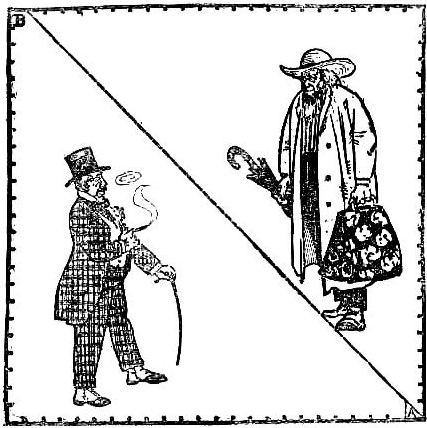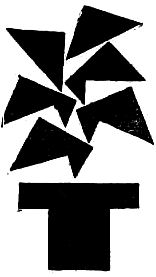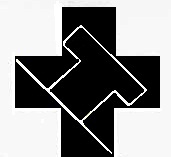



This puzzle shows how easily a person may he deceived in buying gold bricks. Things are not always what they seem. For example, take the accompanying picture for a pattern, and cut any size piece of paper exactly square. Then mark off 24 points on each side, microscopically correct if you can do so. This, for the time being, we suppose to be the gold brick, which is commonly purchased from the affable stranger whom one meets at the hotel.
Each side of the border being divided into 24 equal spaces; note that if the small lines were continued across from border to border in both directions, there would be 24 times 24, or 576 small squares. If these marks were one inch apart, then Mr. Hayseed would be buying 576 square inches of gold! Do you see that diagonal line, running from the corner A up to the second mark near B? Now, cut on that bias line end. Move the top piece up one space on the incline and snip off the little triangular piece A, so as to fill in the top left hand corner. Now remeasure the sides of the gold brick by counting the number of spaces along each side, and see if there are as many small squares as there were before. In other words, see if it is not 23 inches wide by 25 long. That would make but 575 inches of gold that Rubens got and he thought he was buying 576, so it is safe to say that it is not even gold that he purchased, but only brass, worth about 20 cents a pound!
Now, put on your serious thinking cap and study it out: The first measurement was actually 24x24 and contained 576 square inches. Now measure off those points as carefully as possible, the more accurate your measurements are the more inexplicable will be the mystery, then give me the correct dimensions of the rectangle so as to tell what has become of that missing square! This puzzle which I promulgated in my early youth, is a decided improvement upon the time-honored problem of the cut-up checker-board which I have already discussed and presented in modern form.
Euclid, the famous mathematician of Alexandria, who flourished 300 years before the Christian era, with his great work upon geometry which formed the groundwork of all that is known of the sciences. The first volumes contained elementary rules and theorems, accompanied by rigid proof of their accuracy; but the last volume, which was devoted entirely to problematical fallacies was unfortunately lost. That work, which might be looked upon as the culmination of his labors, must have been the grandest book ever attempted by the author. It has been described as a collection of problems or puzzles, wherein the student was to test his knowledge of the subject by detecting the fallacy concealed in the puzzle.
The gold brick problem is given as an illustration of a series of puzzles which I have planned to carry out Euclid's line of leaching, and which will be found to be scattered lavishly through these pages, always accompanied by explanations which will prevent the student from being misled.
The mystery or the Gold Brick is mathematically explained by saying that the new form is really 23 x 25 1/23, which still contains 576 square inches.
2. The Hindoo Flower Trick

Here is an illustration of the famous Hindoo Flower-trick. The fakir plants a seed in the hat and a beautiful flower at once appears; than he asks you to take the seven pieces and arrange them so as to form a Greek cross.
The Hindoo puzzle forms the cross as follows:

3. A Rebus
!FlatVerst To thee my first in days of yore, A king has kneel'd with feelings sore; His loss my next will bring to view, But hope my whole rests not on you. ! Cipher Answer.—2, 12, 15, 3, 11, 8, 5, 1, 4.
BLOCKHEAD
[Page 32]